Holger Rune came back from a first set deficit to defeat Carlos Alcaraz 7/6 6/2 in the final of the Barcelona 500 on Sunday. It was the Dane’s first title since 2023 (Munich). Rune now ties his H2H with Alcaraz at 2-2.
First Set
Holger Rune has been the biggest question mark in men’s tennis over the past 18 months. Bursting into the top-5 in mid 2023 as a 19-year-old, the Dane looked destined to join Sinner and Alcaraz as part of a nextgen triumvirate atop the game. That didn’t materialise, as Rune’s game — and ranking — went sideways, plagued by a rotating cast of coaches, errant shot selection, and numerous fitness and health issues. While 2025 has shown glimpses of promise (he reached the fourth-round in Australia and the final in Indian Wells), fitness and consistency issues continue; just last week Rune retired in his opening match in Monte Carlo, citing illness. In a familiar contrast of fortunes, Alcaraz went on to win the title there. However, this week the Dane acknowledged his errors, and hinted that he has turned the page on this phase of his career:
“I’ve made mistakes in my career, like changing coaches frequently. Now I have a clear idea of how to focus, where I stand on the pitch, and what my fitness level is. All the changes I’ve made have thrown me off track. I lost my way along the way, and now I’ve managed to find my way back. I know that to be at the top, you have to do the right things and not settle for less.”
Back in January I made the bull case for Rune returning to the top-5 in 2025, based largely on the return of Lars Christensen, Rune’s coach since childhood who has an interesting background himself as an acrobat, endowing him with a deep appreciation for biomechanics, as he mentioned in an interview for ATP radio:
“I was always very interested in biomechanics that I think came from my acrobatic career as well, you know, because biomechanics is such an important thing. When I started coaching I got very much into the biomechanics and I tried to build up a system of developing a young kid.”
“if there are limits in those two things (balance and technique) they are going reach a certain level and they’re just going to plateau. It’s not going to be possible to take them any further.”
— Lars Christensen
As I’ve said before, technique is a lever for talent: it amplifies your effort, making it more effective and precise.
The gifts of both players were on display in the early exchanges, with Rune showcasing his forecourt variation against Alcaraz’s absurd defence.
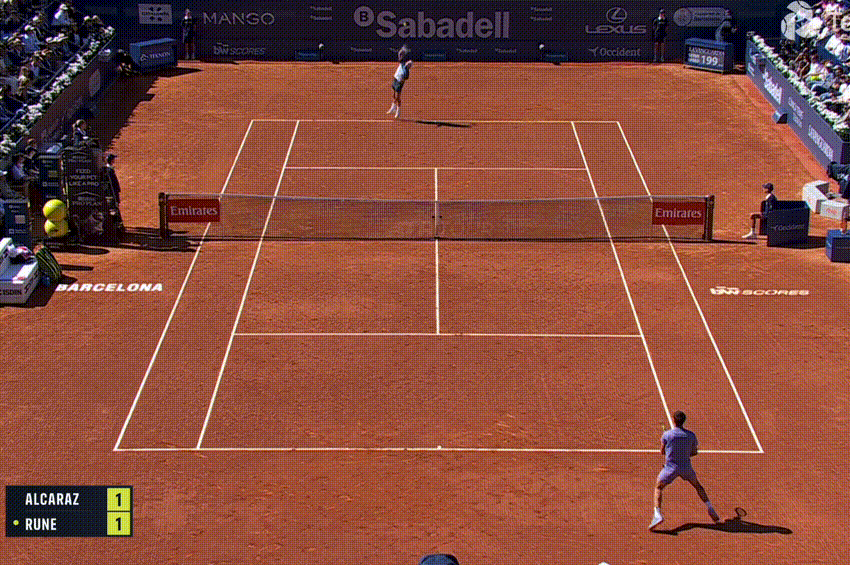
One area of the game that has been hot-and-cold for the Dane is his forehand. It’s the side that can break down more easily, and I’ve wondered whether it is perhaps too compact at times. You can watch a side-by-side of Rune and Alcaraz’s forehand here (both hit with a straight arm), but for a screenshot of the difference in preparation note this frame:

But compact has its perks: when he wants to take it early with intent, it is magnificent:
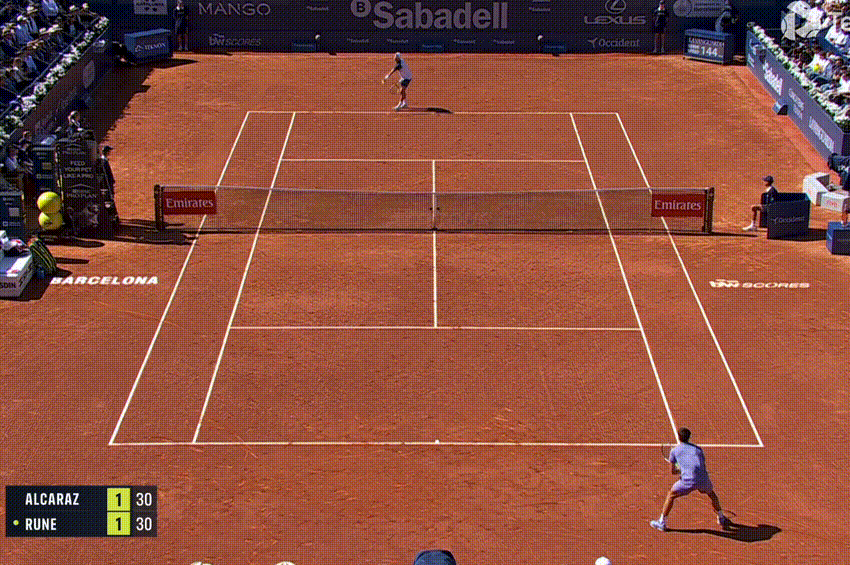
It was that kind of ball-striking that had me thinking how adaptable Rune could be across surfaces a couple of years ago. As I wrote following his 2022 Paris Masters win over Djokovic:
While the power is impressive, what I love about the Dane’s game is his willingness to take time away from opponents. He steps in, redirects, and plays a controlled flat ball. This is exactly what I think is missing from young players today. It’s what Thiem added to his game and allowed him to go 6-1 versus the Big-3 after 2019.
For Alcaraz, he needed no time finding his range, showing Rune his answer for chipped returns:

And deep return positions:
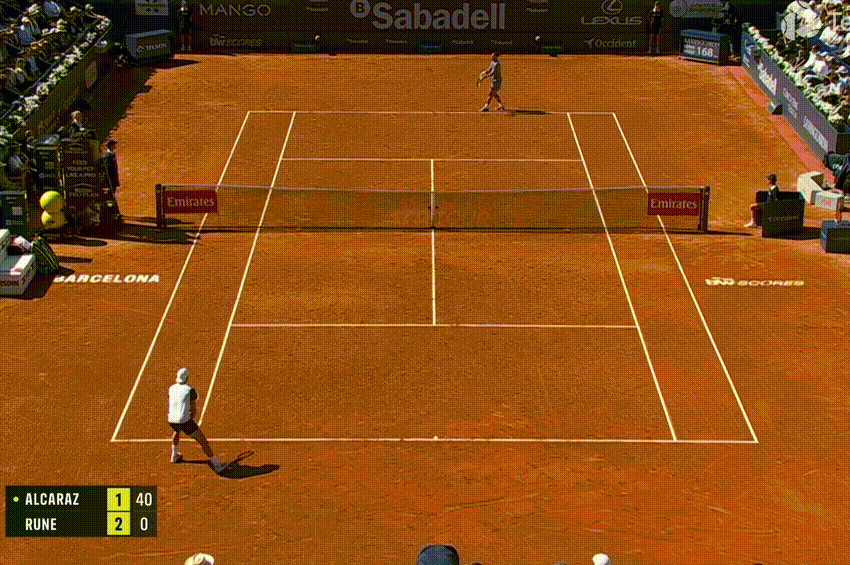
While Alcaraz had been a slow starter last week in Monte Carlo, spraying unforced errors at an alarming rate in opening sets, the Spaniard wasted no time threading the needle on his first break point opportunity here:
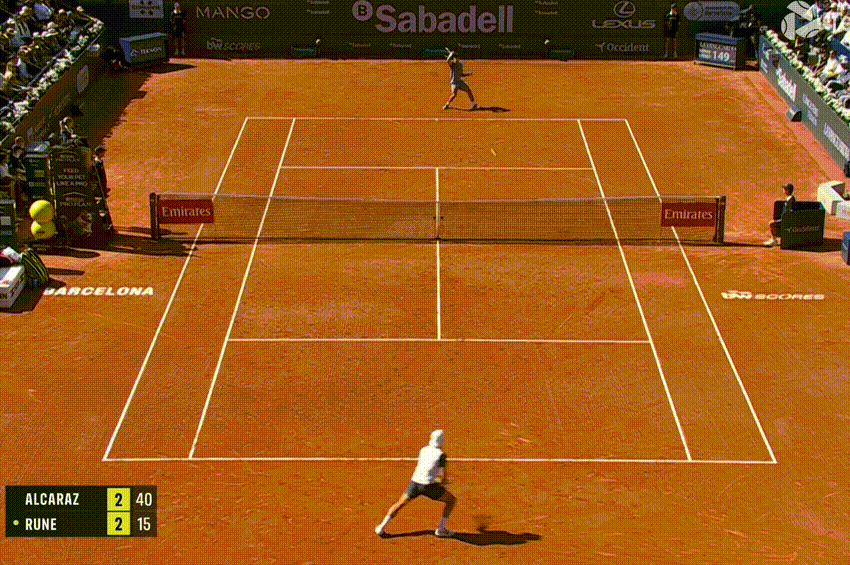
But as quickly as he had earned the break with forehand excellence, he lost it with three forehand errors in the next game, helped along by Rune’s own haymaker at 15-15:
While the mercurial Spaniard is no stranger to sudden fluctuations in his play, it was made all the more stark by the somewhat unusual steadiness of Rune down the other end. I’ve always thought that clay clarifies, or perhaps nudges the Dane’s style, toward the disciplined Djokovic-esque counterpuncher that can build pressure on inpatient opponents. He’s done that to Djokovic himself at times, but he’s often been guilty of playing an eclectic mix of shots and tactics that lacked any coherent strategy. I said as much in his 2023 Rome final loss to Medvedev:
…I can’t help but think Rune’s just showing how dangerous he’s going to be in a few years if he can pull all these polished pieces into a coherent whole. It’s why, despite losing, I keep focusing on Rune in this piece. At 27 Medvedev is an established player—a finished product. His style has hardened after so many years of playing the role of dedicated counterpuncher in the kiln of elite competition. But Rune seems to play huge matches like a doll house session, trying this or that tactic, tasting success with all of them.
And following his loss to Draper last month in Indian Wells:
There’s often a zero or one-hundred speed to Rune’s game at times — the forehand especially. At heart I feel he is a counterpuncher — especially in big moments — but often he takes on points with a premeditated big swingin’ air to vent his frustration.
Jim Courier made similar remarks following a Paris Masters defeat to Zverev late last year:
“I for one have no idea what he’s trying to do out here,” he said.
“It’s like a full-blown jazz exploration. No rhyme, no rhythm.”
“There’s a lot of great things happening, it’s just all scattershot and that is not a recipe for long-term success.
“It’s still a very immature game.”
— Jim Courier on Holger Rune
Today was perhaps a glimpse into a more mature, clear-eyed Rune, albeit one who missed two set point chances on return at 5-4 playing too conservatively. On the second Rune took an aggressive return position, but didn’t do enough with the backhand, tentatively rolling it down the middle. Back peddling to recover for an Alcaraz forehand where… well, you know what comes next
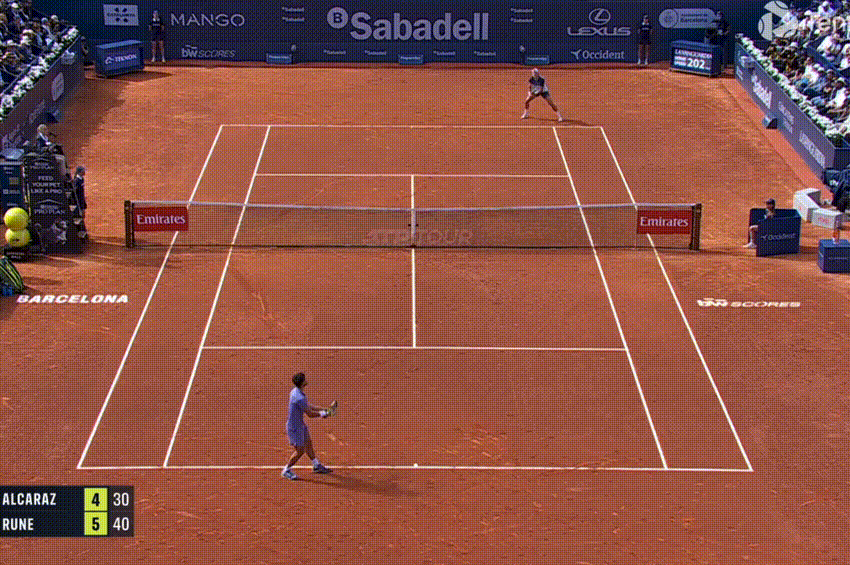
But it would be wrong of me to say that it was all counterpunching from Rune. There was patience and composure interlaced with aggression — especially in the tiebreaker, which the Dane played quite well after a sluggish start.
Like so many of the youngsters coming through, aggression and a forecourt magnetism are almost baked into the generation.1 At 2-3 in the tiebreaker he showcased the stopping power of his backhand:
Technically, that thing is a sledgehammer. Rune has a longer, fuller backswing compared to Alcaraz. There’s more of a drop in the backswing, and the Dane hits with a double-bend hitting-arm structure, whereas Alcaraz hits a straight-left.
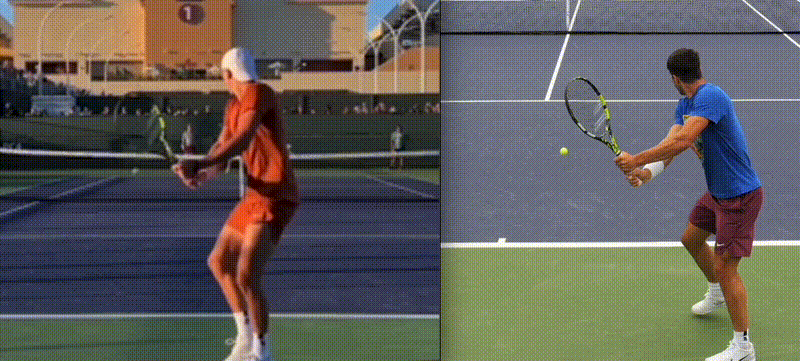
The Dane also outshone Alcaraz in Tennis Insights 2024 backhand metrics:

At 4-4 the Dane kept the heat on, pulling off an excellent running forehand as Alcaraz looked to sneak in using that teleporting North-South movement of his.

At 6-6, having squandered four set points already, Rune stepped up and ripped a confident serve-plus-one forehand:
And took a pretty decent slash on his fifth chance:
Tennis TV: “It looked to us like you were mixing things up nicely. Often from you we see all out attack, but there were changes in pace, and you must be so pleased with how you eventually finished the first set after so many chances.”
Rune: “In the beginning of this first set when I got broken I thought to myself ‘wow, how can I beat him’, and then I thought to myself ‘okay, I don’t need to try to hit every shot on the line’ so I told myself ‘what did Novak do when he beat him [Alcaraz]?’ — and I kind of played it in my mind, the Olympic final, I was watching all of it when they played, obviously an amazing match. And I thought to myself, ‘let’s try to play that kind of style, really make him play a lot of balls’ and I’m really happy on how I stay composed when it mattered. I was also very brave when it mattered.”
Second Set
Alcaraz made inroads at the beginning of the second set, earning two break point chances from Ad-out at 1-0, but Rune had all the answers. Here’s both break points:
Rewatching that game, I think it is the best example of what “peak Rune” looks like: measured hitting from the back, playing with conviction in the forecourt when presented with time and court position. That sounds simple enough, but given the pressure applied by an opponent of Alcaraz’s calibre, it just isn’t.
“You can certainly make a strong case that that was actually the best game he’s [Rune] played so far in the match. Given what he had to come up against, saving the two break points, the highs of wining the set against Alcaraz, then there was maybe a little bit of a dip — totally understandable — but he’s come through it. 10 minutes having to do it the hard way.”
— Tennis TV (hard agree)
On the next changeover Alcaraz went off to receive treatment in the thigh/adductor area. There was clearly an issue, because Alcaraz wouldn’t win another game from here. The movement and shot selection was compromised. He still had looks at 2-1 30-30 though, trying a crush-and-rush to keep the exchanges short:
Rune broke for 3-2, but in the very next game Alcaraz again earned a break point. One of the best rallies of the match unfolded: Alcaraz knifing backhands low crosscourt, wind swirling, Rune staying unbelievably disciplined — crosscourt, crosscourt — before Alcaraz ripped a forehand inside in. Rune was everywhere:
Similar to last week’s Monte Carlo final, Alcaraz’s injury robbed us of a classic after such a promising first set. Rune would close it out 6-2 without much more fight from Alcaraz, who seemed to finish the match out of respect for his opponent and the fellow Spaniards in attendance.
Final Thoughts
If we cast our eyes back to the first break point of the match that Alcaraz won, we’ll note that he had to do just that: win it. In other words, Rune wasn’t giving anything in this match. He played the role of counterpuncher perfectly from a deeper court position, yet never abandoned his forecourt instincts when the opportunity arose. Perhaps the rashest shot he hit all day was the forehand return he threaded on set point.
It’s too early to tell if this is just business as usual — Rune tends to find his clearest identity on clay — or whether this week marks a moment in the young Dane’s career: a genuine step forward in maturity and discipline. We can only hope it’s the latter while we wait for more data points.
It also needs to be said that Alcaraz didn’t play all that well, even before the injury. Sure, Rune probably had a say in that with the way he played today, but it was another erratic performance at times, with the typical brilliance sprinkled in. Alcaraz was all smiles after the handshake, so I suspect the injury is more a tweak than anything, and hopefully he will be fit to go in Madrid next week.
Looking ahead, I am excited about the prospect of so many youngsters finding their groove on the clay. Fils played an incredible match with Alcaraz last week (this week’s was more forgettable) and is building on a solid Sunshine Double performance; Musetti is in career-best form and made his maiden 1000 final last week in Monte Carlo; Fonseca returns to the tour in Madrid next week, and he’s a top-10 clay courter already in my book; what can Mensik do on the dirt? He should like Madrid anyhow. Ditto for Draper.
Bring on Madrid and all its altitude quirkiness. See you in the comments. HC.
My theory is that as newer generations started using lighter and lighter frames as juniors, it opened up opportunities to play closer/farther up the court, improving their forecourt abilities, and giving them numerous opportunities to practice volleys, drop shots, continental grip shots, etc. Compare Zverev/Medvedev/Rublev/Fritz/Tsitsipas/Ruud as a ~gen against Alcaraz/Rune/Sinner/Fonseca/Musetti/Michelsen as the next crop.




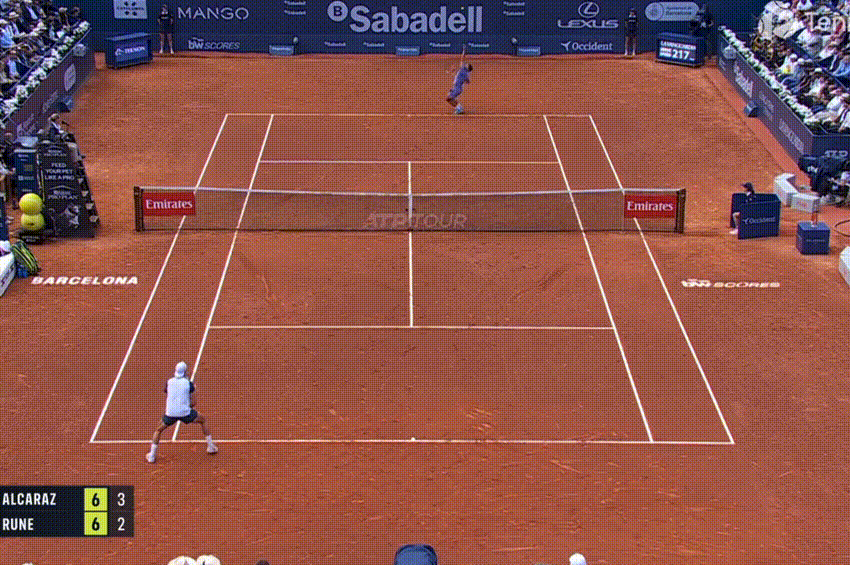

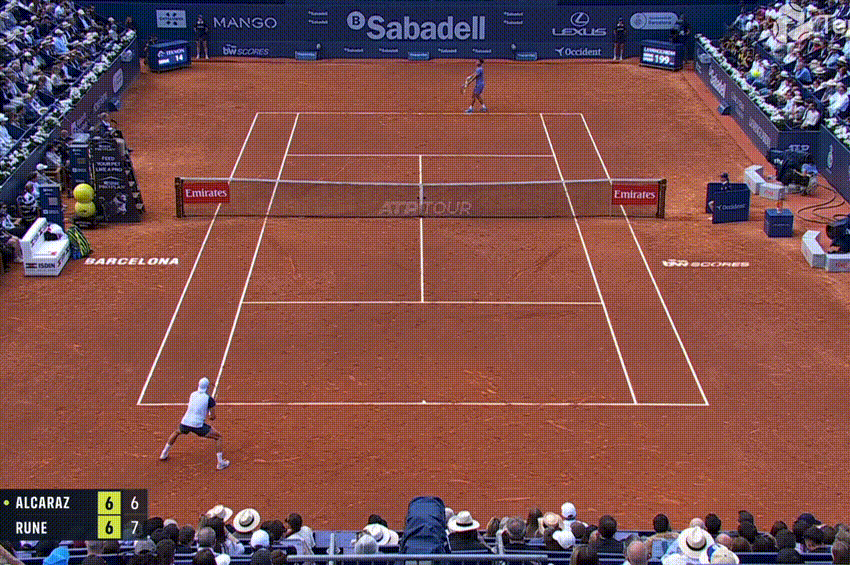

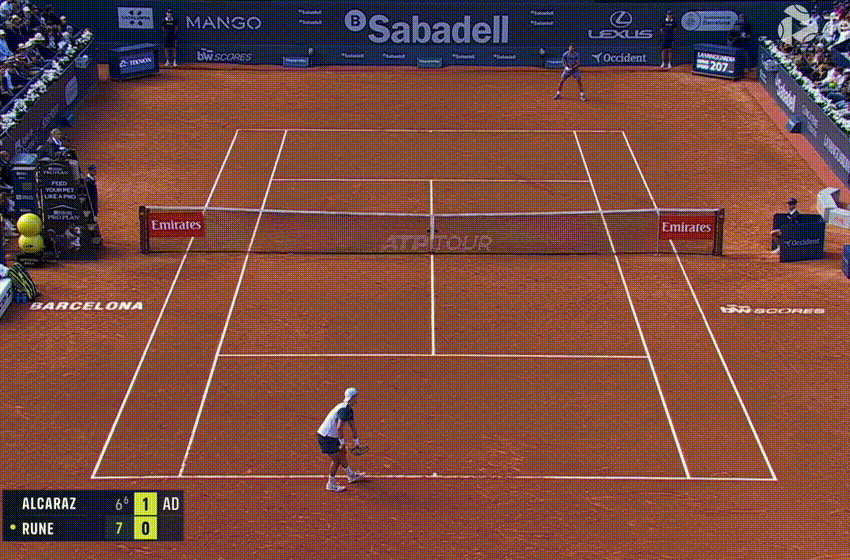
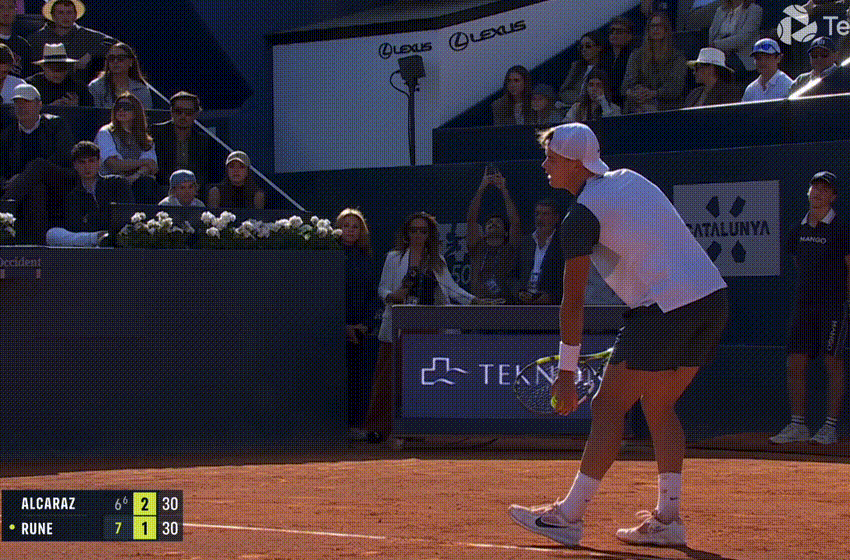

Heard a "psoas" comment from Alcaraz in the MTO request, we'll see today.
Really tight first set from Rune, he held the line and attacked with margin, clarity and decision (if there were mistakes on his side, they were precisely missing the opportunities to attack and pressure). I think Alcaraz has been so hot on the forehand recently that he got greedy with the forehand inversions and the risk level selection. On clay, he can basically run through 90% of the field at that intensity, but there's a few opponents that you just can't overwhelm with power - Djokovic (RG 2023, Oly 2024) and Rune this year being probably the most painful examples. It's possible that an intensity dip from Rune could have let Carlitos come ahead in the late second set, but as we just saw, very high intensity play with lots of sprints and run-arounds also involves physical risk on your side! Compared to something like early Nadal (who also played with massive intensity), the good news for him is that he already has all the moves he needs* to play variety and smart offense; the bad news is that he's sometimes missing the patience and mental discipline (stuff that Rafa was amazing at from the beginning). I felt he was starting to make the necessary tactical shift in the second set, but we won't see that tale finished. We'll see what happens if he plays Madrid, because all those 110%-power heavy forehands are not going to land inside the lines without adjustments here at Meseta Central altitudes.
* Maybe the feet-deep ball is the only lagging area, one which precisely Rune excels at, as I've argued here in the comments before. Clean, linear, flat-ish strokes do a great job on the rise.
Absolutely loved this read—and fully agree: Rune didn’t miss a beat. It was a supremely confident display, with more tactical adaptability than we’re used to seeing from him. And that moment—Alcaraz serving at 4–5 as the migratory birds rattle past, and he smiles—it felt like foreshadowing. Rune read the omen.